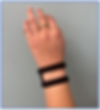What is a TFCC Injury?
- baysidehandtherapy
- Jul 25, 2024
- 3 min read
Updated: Sep 4
Causes, Symptoms and Treatment
If you are experiencing pain on the little finger side of your wrist, you may have come across the term TFCC injury. The TFCC, or Triangular Fibrocartilage Complex, plays an important role in stabilising the wrist during movement. If the TFCC is injured, everyday tasks like turning a key, draining a saucepan or pushing out of a chair can become difficult.
In this article, we’ll answer some common questions about TFCC injuries, including what it is, how they happen, symptoms to look out for, and how hand therapy can help with recovery.
What is the TFCC ?

The TFCC is located between the end of the ulna and the carpal bones in the wrist. It is made up of several ligaments and a cartilaginous disc component. The ligaments play a vital role in stabilising the wrist and forearm bones when we grip and turn our palm up and down. The cartilaginous portion acts as a cushion to absorb force when we push through our hands such as doing a push up.
How does a TFCC injury occur?
Acute injuries to the TFCC are usually the result of a high force through the wrist such as falling onto an outstretched hand, or forceful twisting such as a power drill catching and spinning the wrist around.
The TFCC can also degenerate gradually over time, especially if work or sport involves repeated wrist movement.
What are the symptoms of a TFCC injury?
The signs of a TFCC injury can vary, but typical symptoms include:
Pain on the little finger side of the wrist.
There may be a clicking or catching sensation when rotating the forearm or a feeling of the wrist “giving way” .
Pain that is made worse with twisting motions like opening jars or turning doorknobs.
Pain may be aggravated by strong gripping
Pain when weight-bearing through the wrist, for example when pushing up from a chair.
Reduced grip strength.
Swelling or tenderness in the little finger side of the wrist
There may be tingling in the little finger due to irritation of the ulnar nerve from swelling.
It is important to note that wrist pain can result from many different conditions, so it is important to get a proper assessment.
How is a TFCC Injury Diagnosed?
Diagnosis usually starts with a thorough history and physical examination by a hand therapist or specialist. At Bayside Hand Therapy our therapists perform a series of clinical tests to determine whether the TFCC is involved. Whilst an ultrasound scan may show swelling to suggest a TFCC injury, it cannot properly assess for a TFCC injury. If further detail is needed, an MRI scan may be recommended to confirm the diagnosis and determine the extent of the injury.

What is the Treatment for TFCC Injuries?
The majority of TFCC injuries can be treated without surgery. Hand Therapy treatment for TFCC injuries typically includes:
A period of rest in a Custom-made wrist splint – to limit forearm rotation and allow the ligaments to heal
Treatment modalities to reduce pain and inflammation
Targeted hand therapy exercises – to strengthen the muscles which stabilise the wrist, gentle strengthening and wrist proprioception exercises
Education on how to protect the injured structures, and movements to avoid
A Wrist Widget is frequently used to stabilise the wrist during rotation and protect the TFCC whilst gradually resuming normal activities

Is Surgery Needed for a TFCC Injury?
Surgery is not usually the first step for a TFCC injury. Most people improve with hand therapy. Surgery is usually only considered if significant symptoms persist following a thorough trial of hand therapy, or if there is persistent instability as a result of the injury.
How Long Does it Take to Recover from a TFCC Injury?
Recovery times vary greatly depending on the severity of the injury. As the structures that make up the TFCC have a poor blood supply, healing is typically very slow. Mild TFCC injuries may improve in around 3 months, but more severe injuries can remain painful for 6-12 months and beyond.
Key Takeaway
A TFCC injury can make daily activities painful and frustrating, but with the right diagnosis and early treatment from a qualified hand therapist you can regain the use of your affected hand.
If you are experiencing wrist pain, clicking, or weakness—especially on the little finger side of your wrist—our team of hand therapists is here to help guide you through a tailored recovery plan.
If you think you may have a TFCC injury, please contact us today on 33967798 so we can get you on the road to recovery.


